20 Years of BHA at West Coast Casualty's CD Seminar: Chronicling BHA's Innovative Exhibits
May 03, 2018 —
Beverley BevenFlorez-CDJ STAFFThe Bert L. Howe & Associates, Inc., (BHA) exhibit has been a fixture at West Coast Casualty's Construction Defect Seminar since the mid-1990's. Through the years, BHA has updated their display, but no matter what year, you could count on the BHA exhibit to provide a not-to-be-missed experience.
2008-BHA's sleek, rear projection display includes a screen that promotes the firm's capabilities that can be seen throughout the exhibit hall. This would be one of many innovations BHA has brought to the West Coast Casualty seminar.
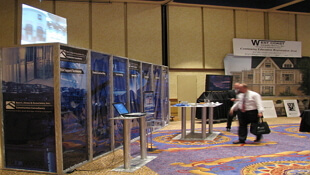
2009-With the success of the rear screen projection, BHA adds additional monitors to provide attendees with more information about BHA.
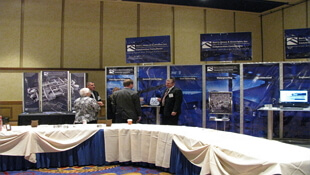
2010-BHA adds an interpretive professional development exhibit targeted to Building Envelope issues allowing adjusters and other non-construction professionals hands on access to the systems and components at the heart of many related such claims.


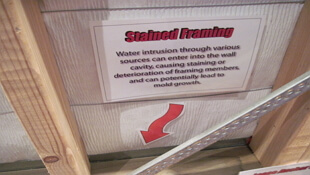
2011-BHA's Swing for Charity challenge is born.

2012-Always innovating, BHA expands its rear projection and professional development offerings to West Coast attendees.

2013-BHA showcases additional capabilities with a twenty-four foot, custom, convex, immersive video experience.

2014-BHA adds an iPhone display to give a hands-on demonstration of their data collection methods.
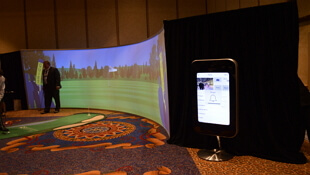
2015-BHA's twenty-four foot , custom, convex, immersive video experience was elevated with two additional rear projection screens, reflecting BHA's newest capabilities and services.

2016-BHA dazzles attendees with their new exhibit comprised of more than 15 integrated, high definition, LCD displays. iPads are stationed on tables to conveniently demonstrate BHA's data collection processes.
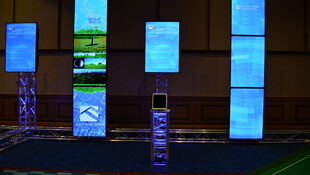
2017-BHA's Swing for Charity Golf Challenge raised $2,225.00 for the National Coalition for Homeless Veterans and $1,900 for Final Salute.
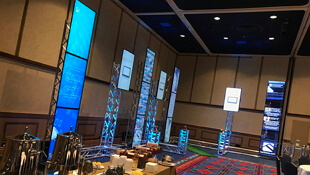
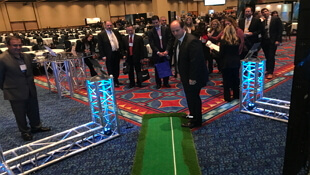
Read the court decisionRead the full story...Reprinted courtesy of
Standard For Evaluating Delay – Directly from An Armed Services Board Of Contract Appeal’s Opinion
October 04, 2021 —
David Adelstein - Florida Construction Legal UpdatesSometimes, it is much better to hear it from the horse’s mouth. That is the case here. The Armed Services Board of Contract Appeal’s (ASBCA) opinion in Appeals of -GSC Construction, Inc., ASBCA No. 59402, 2020 WL 8148687 (ASBCA November 4, 2020) includes an informative discussion of a contractor’s burden when it encounters excusable delay and, of importance, the standard for evaluating delay. It’s a long discussion but one that parties in construction need to know, appreciate, and understand. EVERY WORD IN THIS DISCUSSION MATTERS.
Construction projects get delayed and with a delay comes money because time is money. Many claims are predicated on delay. These can be an owner assessing liquidated damages due to a delayed job or a contractor seeking its costs for delay. Either way, the standard for evaluating delay and the burdens imposed on a party cannot be understated and, certainly, cannot be overlooked. For this reason, here is the discussion on evaluating delay directly from the horse’s mouth in the Appeal of-GSC Construction, Inc.:
The critical path is the longest path in the schedule on which any delay or disruption would cause a day-for-day delay to the project itself; those activities must be performed as they are scheduled and timely in order for the project to finish on time. Wilner v. United States, 23 Cl. Ct. 241, 245 (1991). In Yates-Desbuild Joint Venture, CBCA No. 3350 et al., 17-1 BCA ¶ 36,870, our sister board compiled an excellent and very helpful synopsis of the standards for evaluating delay claims, which I adopt nearly verbatim among the discussion that follows.
Read the court decisionRead the full story...Reprinted courtesy of
David Adelstein, Kirwin Norris, P.A.Mr. Adelstein may be contacted at
dma@kirwinnorris.com
Competition to Design Washington D.C.’s 11th Street Bridge Park
May 07, 2014 —
Beverley BevenFlorez-CDJ STAFFAccording to Architect Magazine, eighty landscape architecture and architecture firms (forty teams) submitted proposals to design the $25-million Washington D.C. 11th Street Bridge Park project. A jury has shortlisted six design teams: “Wallace Roberts & Todd (WRT)/Next Architects, Piet Oudolf with Glenn LaRue Smith/PUSH Studio/WXY Architecture + Urban Design, OLIN/OMA, Workshop: Ken Smith Landscape/Davis Brody Bond, Stoss Landscape Urbanism/Höweler + Yoon Architecture, and Balmori Associates/Cooper, Robertson & Partners.”
The “nonprofit Building Bridges Across the River at THEARC (Town Hall Education Arts Recreation Campus) and the District's Office of Planning” launched the competition in March of this year. Architect Magazine stated that “the goal of” the project is to unify “what some call a ‘long-divided city,’ by connecting Capitol Hill and Anacostia, the neighborhoods on either side of the river.”
Read the court decisionRead the full story...Reprinted courtesy of
Infrared Photography Illuminates Construction Defects and Patent Trolling
October 01, 2013 —
CDJ STAFFReuben Saltzman, a home inspector in the Minneapolis area wrote a piece for the Star Tribune in which he discussed the use of infrared photography in home inspections. Lack of insulation and water intrusion show up clearly on infrared photography where there is not yet any visible damage.
Moist or cold areas show up as darker than their surroundings. Mr. Saltzman included one photo with his article in which the problem shows up as a hot spot: a carpet installer had covered over a floor register.
Mr. Saltzman’s use of infrared photography may be in danger, as he recently learned that a Mississippi firm has actually taken out a patent on using infrared photography for home inspections.
Read the court decisionRead the full story...Reprinted courtesy of
Where Do We Go From Here?
March 21, 2022 —
Christopher G. Hill - Construction Law MusingsGreen Builder CoalitionFor this week’s Guest Post Friday, I welcome an old friend and past Guest Post Friday contributor, Mike Collignon. Mike is the Co-Founder and Executive Director of the Green Builder® Coalition. He engages in national and state-level advocacy and publishes regular content for Green Builder® Media. Mike is also the Chair of the WERS Development Group and has served as the moderator or host for Green Builder® Media’s Impact Series webinars from 2012– present.
This post originally appeared on Green Builder® Media’s Code Watcher.
Do you ever have a line from a song just pop into your head? I get that… a lot. It’s probably due to my lifelong love of music. Anyway, while I was researching this column, the line that cites the title of “Where Do We Go From Here?” by Filter started playing between my ears. You’ll see why in a couple of minutes.
In case you didn’t
read about it here or elsewhere, the IECC development process has undergone an overhaul. It is now following a standards process, yet it retains the word “code” in the name. The residential committee (which is the scope of this column) is now a consensus committee and has been greatly expanded. Proposals are still submitted, reviewed and voted on by the committee. On the surface, it doesn’t sound like much has changed. As they say, the devil is always in the details.
Read the court decisionRead the full story...Reprinted courtesy of
The Law Office of Christopher G. HillMr. Hill may be contacted at
chrisghill@constructionlawva.com
Modified Plan Unveiled for Chicago's Sixth-Tallest Tower
February 15, 2018 —
Jeff Yoders – ENRThe Chicago Plan Commission on Jan. 18 approved a $700-million development that, as presented, would include the city’s sixth-tallest building.
Read the court decisionRead the full story...Reprinted courtesy of
Jeff Yoders, Engineering News-RecordMr. Yoders may be contacted at
yodersj@enr.com
SunTrust Will Pay $968 Million to Resolve Mortgage Probes
June 18, 2014 —
Tom Schoenberg – BloombergSunTrust Banks Inc. (STI) agreed to pay $968 million to resolve federal and state claims that a unit misrepresented the quality of mortgages the bank originated and deceived homeowners on loans it serviced.
The agreement covers loans SunTrust Mortgage made from January 2006 through March 2012 that were backed by the Federal Housing Administration even though they didn’t meet agency requirements, the Justice Department said in a statement today. Atlanta-based SunTrust disclosed the agreement in an October regulatory filing and has already accounted for the payment.
“SunTrust’s conduct is a prime example of the widespread underwriting failures that helped bring about the financial crisis,” Attorney General Eric Holder said in a statement. “We will continue to hold accountable financial institutions that, in the pursuit of their own financial interests, misuse public funds and cause harm to hardworking Americans.”
Read the court decisionRead the full story...Reprinted courtesy of
Tom Schoenberg, BloombergMr. Schoenberg may be contacted at
tschoenberg@bloomberg.net
Contractors with Ties to Trustees Reaped Benefits from LA Community College Modernization Program
March 03, 2011 —
Gale Holland, Michael Finnegan and Doug Smith, Los Angeles TimesIn the latest installment of the “Billions To Spend” series of investigative reports focused on construction defects, management, and cost issues relevant to LACC’s Community College Modernization Projects, the LA Times examines the costs associated with the various layers of construction management and benefits that accrued to contractors with ties to LACC trustees.
�The reporting by the Times is seemingly critical of the project’s utilization of “body shops” an industry term for companies that function as employers of record. The article segment published today cites a number of circumstances wherein their utilization appears to have escalated costs substantially.
�“To gauge the cost of the staffing system, The Times reviewed thousands of pages of financial records from April 2007, when URS began managing the program, to July 2010. Reporters identified two dozen contractors serving as conduits for pay and benefits for employees they did not supervise.
�At least 230 people were employed in this manner, at a total cost of about $40 million, the records show.
�Approximately $18 million of the total was paid to the employees, according to the Times analysis. The remaining $22 million went to profit and overhead for contractors, the records indicate.
�For employees on its own payroll, the district says that medical and other benefits increase compensation costs 40% above base salaries. So if the district had employed its construction staff directly, the total cost for the period studied would have been $25 million instead of $40 million, a savings of $15 million, The Times calculated.”
�Read Full Story...
Read the court decisionRead the full story...Reprinted courtesy of




































































